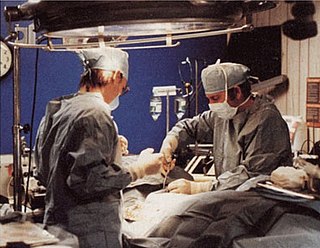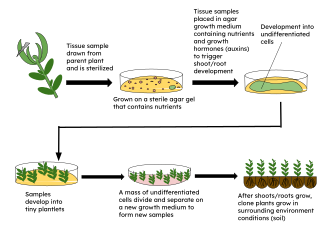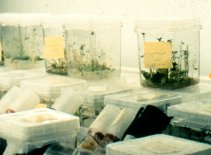Related Research Articles

Cryonics is the low-temperature freezing and storage of human remains, with the speculative hope that resurrection may be possible in the future. Cryonics is regarded with skepticism within the mainstream scientific community. It is generally viewed as a pseudoscience, and its practice has been characterized as quackery.
Cryobiology is the branch of biology that studies the effects of low temperatures on living things within Earth's cryosphere or in science. The word cryobiology is derived from the Greek words κρῧος [kryos], "cold", βίος [bios], "life", and λόγος [logos], "word". In practice, cryobiology is the study of biological material or systems at temperatures below normal. Materials or systems studied may include proteins, cells, tissues, organs, or whole organisms. Temperatures may range from moderately hypothermic conditions to cryogenic temperatures.

Vitrification is the full or partial transformation of a substance into a glass, that is to say, a non-crystalline amorphous solid. Glasses differ from liquids structurally and glasses possess a higher degree of connectivity with the same Hausdorff dimensionality of bonds as crystals: dimH = 3. In the production of ceramics, vitrification is responsible for their impermeability to water.

Germplasm are genetic resources such as seeds, tissues, and DNA sequences that are maintained for the purpose of animal and plant breeding, conservation efforts, agriculture, and other research uses. These resources may take the form of seed collections stored in seed banks, trees growing in nurseries, animal breeding lines maintained in animal breeding programs or gene banks. Germplasm collections can range from collections of wild species to elite, domesticated breeding lines that have undergone extensive human selection. Germplasm collection is important for the maintenance of biological diversity, food security, and conservation efforts.

Micropropagation or tissue culture is the practice of rapidly multiplying plant stock material to produce many progeny plants, using modern plant tissue culture methods.
A cryoprotectant is a substance used to protect biological tissue from freezing damage. Arctic and Antarctic insects, fish and amphibians create cryoprotectants in their bodies to minimize freezing damage during cold winter periods. Cryoprotectants are also used to preserve living materials in the study of biology and to preserve food products.

Gene banks are a type of biorepository that preserves genetic material. For plants, this is done by in vitro storage, freezing cuttings from the plant, or stocking the seeds. For animals, this is done by the freezing of sperm and eggs in zoological freezers until further need. With corals, fragments are taken and stored in water tanks under controlled conditions. Genetic material in a 'gene bank' is preserved in a variety of ways, such as freezing at -196 °C in liquid nitrogen, being placed in artificial ecosystems, or put in controlled nutrient media.

Phytomorphology is the study of the physical form and external structure of plants. This is usually considered distinct from plant anatomy, which is the study of the internal structure of plants, especially at the microscopic level. Plant morphology is useful in the visual identification of plants. Recent studies in molecular biology started to investigate the molecular processes involved in determining the conservation and diversification of plant morphologies. In these studies transcriptome conservation patterns were found to mark crucial ontogenetic transitions during the plant life cycle which may result in evolutionary constraints limiting diversification.

Oocyte cryopreservation is a procedure to preserve a woman's eggs (oocytes). This technique has been used to enable women to postpone pregnancy to a later date – whether for medical or social reasons. Several studies have shown that most infertility problems are due to germ cell deterioration related to aging. The procedure intends that the woman may choose to have the eggs thawed, fertilized, and transferred to the uterus as embryos to facilitate a pregnancy in the future. The procedure's success rate varies depending on the age of the woman, with the odds being higher in younger, adult women.
Cryofixation is a technique for fixation or stabilisation of biological materials as the first step in specimen preparation for the electron microscopy and cryo-electron microscopy. Typical specimens for cryofixation include small samples of plant or animal tissue, cell suspensions of microorganisms or cultured cells, suspensions of viruses or virus capsids and samples of purified macromolecules, especially proteins.

Cryopreservation or cryoconservation is a process where biological material - cells, tissues, or organs - are frozen to preserve the material for an extended period of time. At low temperatures any cell metabolism which might cause damage to the biological material in question is effectively stopped. While between 0 and -30ºC, ice crystals change their morphology, what amplifies the “knife” effect. Cryopreservation is an effective way to transport biological samples over long distances, store samples for prolonged periods of time, and create a bank of samples for users. Molecules, referred to as cryoprotective agents (CPAs), are added to reduce the osmotic shock and physical stresses cells undergo in the freezing process. Some cryoprotective agents used in research are inspired by plants and animals in nature that have unique cold tolerance to survive harsh winters, including: trees, wood frogs, and tardigrades.

Plant tissue culture is a collection of techniques used to maintain or grow plant cells, tissues, or organs under sterile conditions on a nutrient culture medium of known composition. It is widely used, to produce clones of a plant in a method known as micropropagation. Different techniques in plant tissue culture may offer certain advantages over traditional methods of propagation, including:
Ovarian tissue cryopreservation is cryopreservation of tissue of the ovary of a female.
Semen cryopreservation is a procedure to preserve sperm cells. Semen can be used successfully indefinitely after cryopreservation. It can be used for sperm donation where the recipient wants the treatment in a different time or place, or as a means of preserving fertility for men undergoing vasectomy or treatments that may compromise their fertility, such as chemotherapy, radiation therapy or surgery. It is also often used by trans women prior to medically transitioning in ways that affect fertility, such as feminizing hormone therapy and orchiectomies.
Cryopreservation of embryos is the process of preserving an embryo at sub-zero temperatures, generally at an embryogenesis stage corresponding to pre-implantation, that is, from fertilisation to the blastocyst stage.

A viability assay is an assay that is created to determine the ability of organs, cells or tissues to maintain or recover a state of survival. Viability can be distinguished from the all-or-nothing states of life and death by the use of a quantifiable index that ranges between the integers of 0 and 1 or, if more easily understood, the range of 0% and 100%. Viability can be observed through the physical properties of cells, tissues, and organs. Some of these include mechanical activity, motility, such as with spermatozoa and granulocytes, the contraction of muscle tissue or cells, mitotic activity in cellular functions, and more. Viability assays provide a more precise basis for measurement of an organism's level of vitality.
Grapevine virus A (GVA) is a moderately common genetic virus that affects Vitis vinifera and American Vitis grapevine species throughout the world and can be fatal if not treated. Grapevine virus A is in the family Betaflexiviridae and genus Vitivirus. The common name for this virus is grapevine closterovirus. Common symptoms in infected grapevines include stem pitting. Although there is a treatment available to cure infected grapevines, it is not one hundred percent effective, so preventative measures are the best solution to the virus. Every inhabited continent on the globe has had breakouts of grapevine closterovirus due to the complex genetic makeup of the virus. Grapevine virus A has a single-stranded RNA genome, which is similar to that of Grapevine virus B. There are multiple strains of the virus that vary both molecularly and biologically which account for the slightly different symptoms exhibited by infected plants.

Cryoconservation of animal genetic resources is a strategy wherein samples of animal genetic materials are preserved cryogenically.
Cryonics Institute (CI) is an American nonprofit foundation that provides cryonics services. CI freezes deceased humans and pets in liquid nitrogen with the hope of restoring them with technology in the future.
Cryopreservation of testicular tissue is an experimental method being used to preserve fertility in pre-pubescent males, or males who cannot produce sperm, to allow them the option of having biological children.
References
- 1 2 3 Reed BM (2017-08-01). "Plant cryopreservation: a continuing requirement for food and ecosystem security". In Vitro Cellular & Developmental Biology - Plant. 53 (4): 285–288. doi: 10.1007/s11627-017-9851-4 . ISSN 1475-2689. S2CID 32177737.
- ↑ O'Brien C, Hiti-Bandaralage JC, Folgado R, Lahmeyer S, Hayward A, Mitter N (2020). "Developing a cryopreservation protocol for avocado ( Persea americana Mill.) apical shoot tips using different antioxidants". Acta Horticulturae (1285): 15–22. doi:10.17660/ActaHortic.2020.1285.3. ISSN 0567-7572. S2CID 226751510.
- ↑ Sopade PA, Samosir YM, Rival A, Adkins SW (December 2010). "Dehydration improves cryopreservation of coconut (Cocos nucifera L.)". Cryobiology. 61 (3): 289–96. doi:10.1016/j.cryobiol.2010.09.007. PMID 20959171.
- ↑ Panis B, Swennen R (1995). "Cryopreservation of Germplasm of Banana and Plantain (Musa Species)". Cryopreservation of Plant Germplasm I. Biotechnology in Agriculture and Forestry. Vol. 32. Berlin, Heidelberg: Springer Berlin Heidelberg. pp. 381–397. doi:10.1007/978-3-662-03096-7_27. ISBN 978-3-642-08184-2.
- 1 2 3 Wilms H, Fanega Sleziak N, Van der Auweraer M, Brands M, Verleije M, Hardeman D, et al. (7 September 2020). "Development of a fast and user-friendly cryopreservation protocol for sweet potato genetic resources". Scientific Reports. 10 (1): 14674. Bibcode:2020NatSR..1014674W. doi:10.1038/s41598-020-70869-3. PMC 7477159 . PMID 32895398.
- ↑ da Silva RL, de Souza EH, de Jesus Vieira L, Pelacani CR, Souza FV (2017-05-17). "Cryopreservation of pollen of wild pineapple accessions". Scientia Horticulturae. 219: 326–334. doi:10.1016/j.scienta.2017.03.022. ISSN 0304-4238.
- ↑ Kartha KK (1982). In vitro growth responses and plant regeneration from cryopreserved meristems of cassava (Manihot esculenta Crantz)*). Casilla de Correos 209, Corrientes (3400) Argentina.: Facultad de Ciencias Agrarias, Instituto de Botanica del Nordeste. OCLC 709654438.
{{cite book}}: CS1 maint: location (link) - 1 2 3 Panis B, Piette B, Swennen R (2005-01-01). "Droplet vitrification of apical meristems: a cryopreservation protocol applicable to all Musaceae". Plant Science. 168 (1): 45–55. doi:10.1016/j.plantsci.2004.07.022. ISSN 0168-9452.
- ↑ Escobar RH, Mafla G, Roca WM (April 1997). "A methodology for recovering cassava plants from shoot tips maintained in liquid nitrogen". Plant Cell Reports. 16 (7): 474–478. doi:10.1007/s002990050263. PMID 30727635.
- ↑ Hu, Chun (2015), Liu, Yanze; Wang, Zhimin; Zhang, Junzeng (eds.), "Chrysanthemum morifolium Ramat 菊花 (Juhua, Florists Chrysanthemum)", Dietary Chinese Herbs: Chemistry, Pharmacology and Clinical Evidence, Vienna: Springer, pp. 681–691, doi:10.1007/978-3-211-99448-1_77, ISBN 978-3-211-99448-1 , retrieved 2020-11-03